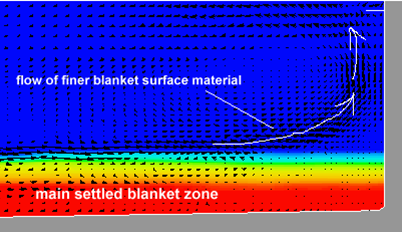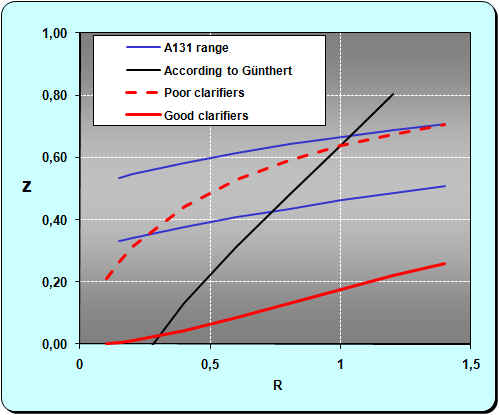
SHORT-CIRCUITING
In consequence of short-circuiting, the feed prematurely reaches the effluent and the underflow.
Short-circuiting occurs in two modes. In brief, the two modes are referred to as
Short-circuiting into the effluent.
Short-circuiting into the underflow (sludge).
For details on short-circuiting into the effluent see for instance Flow Science:

Typical circular clarifier flow pattern (NEFCO)
While "effluent short-circuiting" is reasonably well described and treated in most final clarifiers, "underflow short-circuiting" is frequently not correctly understood, described and controlled.

Underflow short-circuiting results from insufficient capacity of sludge transport. Then, instead of withdrawing the sludge bottom concentration, a mixture of the bottom and the inlet concentration is withdrawn. Fraction of the short-circuited flow with the incoming concentration of suspended solids Xa is noted z
and called "short-circuiting coefficient" (with values 0 - 1). From mass balance around the sludge outlet point:|
QrXr = zQ0Xa + (1- z)QrXbrXb |
(10) |
Equation can be rearranged to
|
z = (Xr - Xb)/(Xa - Xb) |
(11) |
The advantage of this approach is that z can be calculated from routinely measured concentrations Xr and Xa. The bottom sludge concentration can be easily measured.
Early expression of the short-circuiting coefficient comes from GŁnthert (1984), who expressed both the recycle ratio and the short-circuiting coefficient in percents. If modified to fractions, his equation is:
|
k = 0.2347 ln(R) + 0.3475 |
(12) |
where, by GŁnthert's definition:
|
k = Qsc/(1+R)Q0 |
(13) |
and Qsc is the short-circuiting flow.
The relation between z and k is
|
z = k(1+R) = (0.2347 ln(R)+0.3475)/(1+R) |
(14) |
Though GŁnthert claimed that equation 12 is valid from R 0.15 to 1.83, the values of Qsc/Q0 are negative below R approx. 0.22 and greater than 1 above R = 1.4. In his field measurements at several plants, the clarifier Buchloe II produced typically Xr ~ 6 g/l and Xb ~ 13 g/l. It has to be noted that the bottom concentration would double the recycled concentration at a poorly designed clarifier only.

It has been found that new clarifiers at the treatment plant in Prague (diameter 44 m) reveal Xr/Xb > 0.9, indicating very small z (about 0.1). The smaller z, the shallower the sludge blanket and the higher the limiting load.
German guideline
A131 recommends to calculate the sludge blanket height from the bottom concentration but fails to offer methodology how to calculate the bottom concentration. Instead, it recommends to use Xr ~ 0.7Xb (or 0.5-0.7), regardless of R. Interpretation in relation to short circuiting is shown in the figure.

It can be seen from the figure that the main discrepancies are at low recycle ratios. GŁnthert's prediction is too low, that of A131 too high.
The value of z depends on a number of factors. Those controllable are:
clarifier inlet arrangement,
bottom slope,
shape, height and rotational speed of scrapers and
recycle ratio.
Excessive sludge recycling is contra productive, while too small recycling requires high degree of activated sludge thickening. Optimum conditions are achieved by a correct algorithm of the recycle flow control.
Correctly designed and operated up-to-date clarifiers are significantly better than those presumed by A 131.